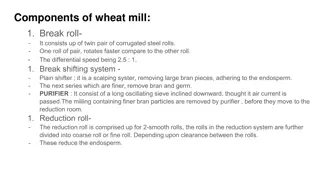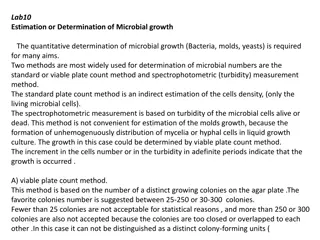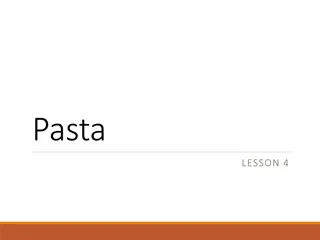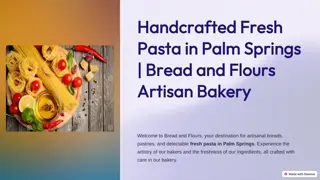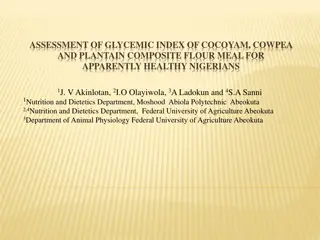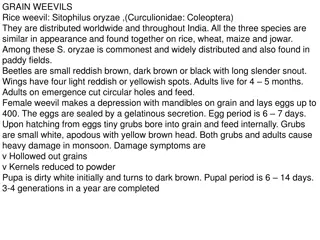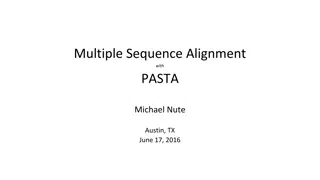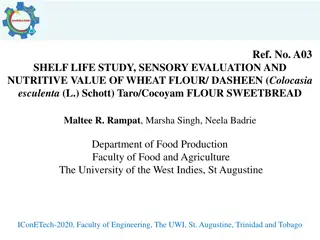The Versatility of Pasta: From Flour to Plate
Explore the world of pasta, from understanding different flour products used to creating homemade pasta dishes. Discover the reasons behind pasta's popularity, its various uses in recipes, and the differences between fresh and dried pasta. Learn about the key to successful pasta making and the benefits of consuming complex carbohydrates found in pasta dishes.
Download Presentation

Please find below an Image/Link to download the presentation.
The content on the website is provided AS IS for your information and personal use only. It may not be sold, licensed, or shared on other websites without obtaining consent from the author.If you encounter any issues during the download, it is possible that the publisher has removed the file from their server.
You are allowed to download the files provided on this website for personal or commercial use, subject to the condition that they are used lawfully. All files are the property of their respective owners.
The content on the website is provided AS IS for your information and personal use only. It may not be sold, licensed, or shared on other websites without obtaining consent from the author.
E N D
Presentation Transcript
Objectives: To explain the purposes of the flour products used in pasta To understand the need and amount of servings from pasta To experience the differences in fresh and dried pasta To demonstrate the mechanics of making homemade pasta and sauce
Whos eaten pasta within the last week? What kind?
Why is pasta so popular in our diets? Quick & easy to prepare Inexpensive Delicious Nutritious Versatile
What are the different ways that pasta may be used in recipes? Served hot or cold Soups, desserts Parts of the meal - Appetizers, Salads Stuffed (spinach/ricotta) With red sauces, cream sauces, garlic
How is Pasta Made https://www.youtube.com/watch?v=kZw5zMqmTdE
There are 2 types of pasta: a. based sauce often with meat Dried: best with heartier, tomato- Shelf life up to one year 1# dried pasta yields 3 pounds after cooking.
b. Fresh: Best with rich cream, butter, & cheese sauces ex. Alfredo May be wrapped in plastic & frozen for 3 days Do not thaw before cooking 1# fresh pasta yields 2 pounds after cooking.
The KEY to making a successful pasta is Durum wheat which is a hard wheat. Durum wheat: has a nutty flavor the ability to retain both shape and firmness. Homemade Pasta https://www.youtube.com/watch?v=mV7_-_D26vY
WhyCOMPLEX CARBOHYDRATES? Provides complex B vitamins. These vitamins help the body to release energy and to work more efficiently Provides energy/fuel which is released slowly
6 of the 8 essential amino acids Athletes eat pasta because the complex carbohydrates become glucose stored in the muscles which release energy as needed.
Helps us feel full Provides some fiber in the diet Low in sodium Provides minerals such as iron & calcium, folic acid(prevention of some birth defects in pregnant women)
Kitchen family assignment Create a low-fat, nutritional topping to be used on any pasta. Remember, it is not the pasta that is fattening and high in calories but the topping that you put with pasta.
List ways that you can make a pasta dish healthy? Tomato-based sauce provides lycopene, a naturally occurring antioxidant found in tomatoes Low fat ingredients ex. Cheeses, low-fat or skim milk instead of cream
Substitute non-fat yogurt, reduced fat mayo, low-fat sour cream Use whole grain/wheat pasta Pasta itself has no fat, it is the sauces etc.
Pair pasta with legumes such as beans & lentils (protein rich) Add vegetables Use lean meats or fish Use small amounts of oils
Where did pasta originate? Italy, we like to say but it the Chinese made these noodles first Northern Italy : Herbs & sauces with a lot of butter , cheeses for cream sauces Rice's (risotto), corn for Polenta, gnocchi Southern Italy: Healthier, tomato sauces, olive oil, eggplant
FUN FACTS The pasta machine was brought to America by Thomas Jefferson. In 1848, the first pasta manufacturing company was opened in Brooklyn, New York. Pasta became an upscale menu item in the 1980 s .
What is the best way to store cooked pasta? Refrigerate in airtight container 3 to 5 days (add a bit of oil to prevent sticking) Freeze pasta s that are used in baked recipes Best to prepare, freeze and then bake Store uncooked, dry pasta up to one year in a cool, dry place.
Long Pasta Commonly used by Easterners
Short Pasta Commonly used by Midwesterners
Soup Pasta Makes clear soups more nutritional
Shaped Pasta Ravioli Often stuffed Canelloni Tortellini
How to Cook Pasta Perfectly https://www.youtube.com/watch?v=u 0p_dBCEDs4
Cooking Tips Cooking time determined by size and thickness of pasta Cooked al Dente means firm but not soggy Fresh pasta usually requires shorter cooking time
Shocking pasta means: Rinsing cold water over pasta to stop the cooking process. Shock angel hair pasta, pasta to be used in soups, salads and pasta needed to be refrigerated
Additional notes: A serving of pasta is __________ cooked pasta. cup No more than portion of your plates should be grains. 1 c. pasta = 200 calories
At least 1/2 of your daily servings of grains should be whole grain. The key to success in making pasta from scratch is using durum wheat which is refined into semolina flour which creates a high quality of pasta.
All-purpose flour vs. Semolina flour White Yellow Smooth Coarse
3 or more servings of whole grains per day (which is at least of your servings of whole grains). ____ of our diet should be composed of complex carbohydrates. 55% - 60%
What is the purpose of: Adding salt to the water? flavor Oil to water? none







